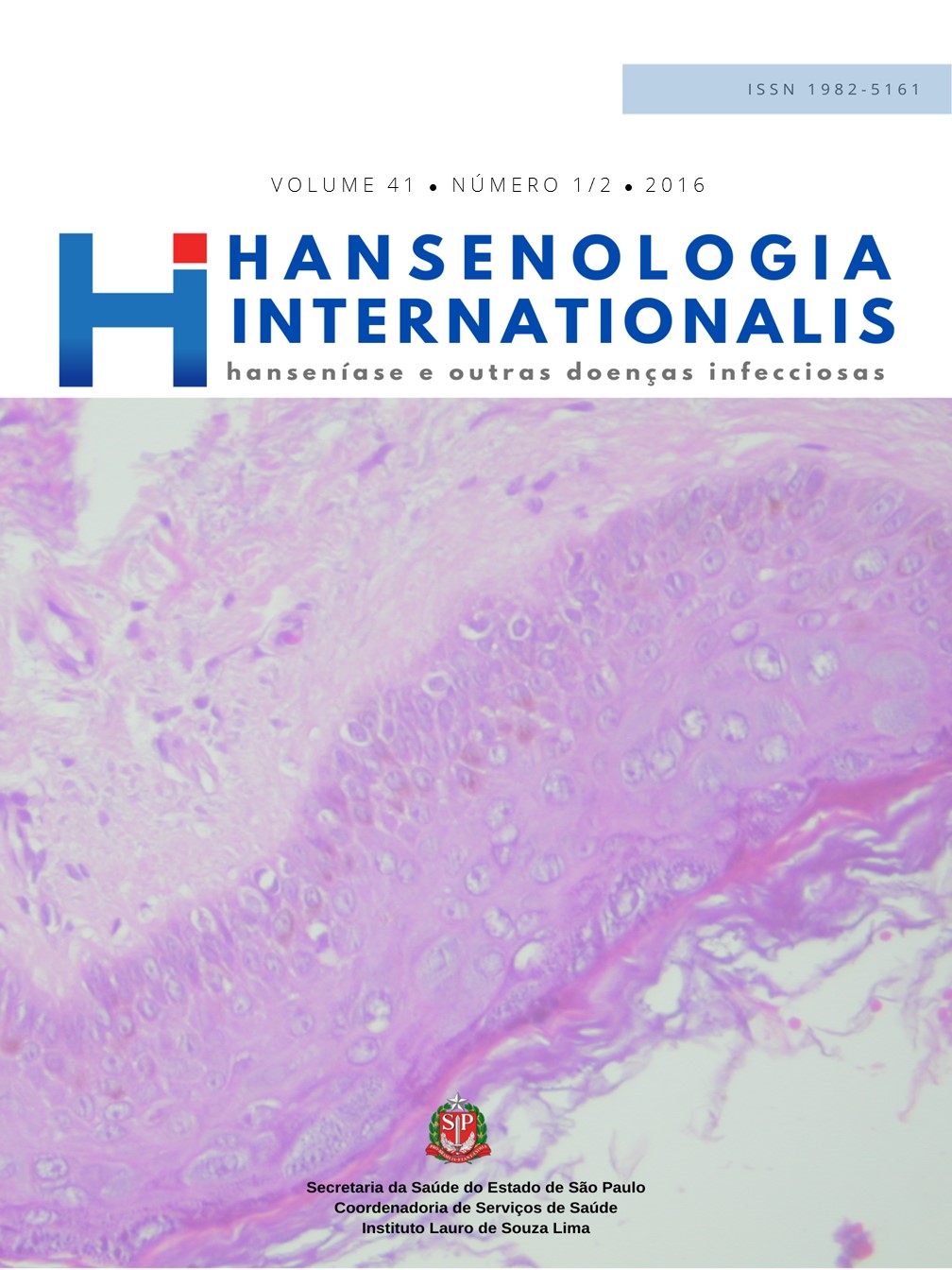Abstract
This study aimed to determine whether individuals affected by leprosy properly performed selfcarepractice and possible interfering factors. It is a documentary, observational and descriptive study of household survey.The sample covered all the eleven patients during one year, of a municipality with120.000 inhabitants in SP state. Clinical data and prescription care records were obtained from the medical forms. The interview and observation of self-care practices were held at home.The participantswere asked to identify the problems resulting from the disease, describing which, how and when theydid the necessary self-care, being classified as: held properly, partially or not performed. The study was approved by the Committee of Ethics in Research (Nº 06/2007). Of the five who presented level 2 disabilities, three partially performed; two did not perform self-care. They demonstrated difficulties in accepting the physical commitment and incorporate the daily practices for multiple causes factors, sodid those with level 1. The need for maintaining labor work, with full-time exposure to physical trauma, can lead to concealment of disease, either for themselves or for society, and hinder self-careactions, either by lack of time as for not accepting the disease.The paternalistic model, fragmenting andmechanical of health care, suggests a tendency by leading to rely on institutional services, deconstructing the autonomy and individual responsibility for their health status, discouraging selfcareactions at home.
References
2 Araújo MG. Hanseníase no Brasil. Rev Soc Bras Trop. 2003;36(3):373-82. doi: 10.1590/S0037-86822003000300010.
3 Ministério da Saúde (BR), Secretaria de Vigilância em Saúde, Departamento de Vigilância Epidemiológica. Manual de Prevenção de Incapacidades [Internet]. 3a ed. Brasília: Ministério da Saúde; 2008. [cited 2015 Mai 27]. Available from: http://bvsms.saude.gov.br/bvs/publicacoes/manual_prevencao_incapacidades.pdf
4 Duerksen F. Reabilitação. In: Opromolla DVA, Baccarelli R, organizadores. Prevenção de incapacidades e reabilitação em hanseníase [Internet]. Bauru: Instituto Lauro de Souza Lima; 2003. p. 3-4. [cited 2015 Fev 22]. Available from: http://hansen.
bvs.ilsl.br/textoc/livros/OPROMOLLA_DILTOR_prevencao/aspectos%20gerais/PDF/reabilit.pdf
5 Seshadri D, Khaitan BK, Khanna N, Sagar R. Dehabilitation in the era of elimination and rehabilitation: a study of 100 leprosy patients from a tertiary care hospital in India. Lepr Rev [Internet]. 2015 [cited 2015 Abr 02];86(1):62-74. Available from: https://www.lepra.org.uk/platforms/lepra/files/lr/Mar15/1850.pdf
6 George JB. Teorias de enfermagem: os fundamentos à prática profissional. 4a ed. Porto Alegre: Artmed; 2000. 375 p.
7 Brito KKG, Soares MJGO, Costa MML, Oliveira SHS. Práticas e limitações de clientes com hanseníase no cuidar das lesões cutâneas. Rev Enferm UFPE on line. 2014:8(1):16-21. doi: 10.5205/reuol.4843-39594-1-SM.0801201403
8 Nardi SMT, Paschoal VDA, Chiaravalloti-Neto F, Zanetta DMT. Deficiências após a alta medicamentosa da hanseníase: prevalência e distribuição espacial. Rev Saúde Pública [Internet]. 2012 [cited 2015 Fev 14];46(6):969-77. Available from: http://www.scielo.br/pdf/rsp/v46n6/ao4048.pdf
9 Alberts CJ, Smith WCS, Meima A, Wang L, Richardus JH. Potential effect of the World Health Organization’s 2011-2015 global leprosy strategy on the prevalence of grade 2 disability: a trend analysis. Bull World Health Organ [Internet]. 2011 July [cited 2015 mai 02];89(7):487-95. Available from: http://www.who.int/bulletin/volumes/89/7/10-085662/en/
10 Silva AC, Ferreira RC, Ferreira MAA, Ribeiro MTF. Association between the degree of physical impairment from leprosy and dependence in activities of daily living among the elderly in a health unit in the State of Minas Gerais. Rev Soc Bras Med Trop. 2014;47(2):212-7. doi: 10.1590/0037-8682-0012-2014
11 Pieri FM, Ramos ACV, Crispim JA, Pitiá ACA, Rodrigues LBB, Silveira TRS, et al . Fatores associados às incapacidades em pacientes diagnosticados de hanseníase: um estudo transversal. Hansen Int [Internet]. 2012 [cited 2015 Mar 16];37(2):22-30. Available from: http://www.ilsl.br/revista/detalhe_artigo.php?id=12010
12 Leite IF, Arruda AJCG, Vasconcelos DIB, Santana SC, Chianca KSV. A qualidade de vida de pacientes com hanseníase crônica. Rev Enferm UFPE on line. 2015;9(6):8165-71. doi:10.5205/reuol.7585-66362-1-ED.0906201503
13 Deepak S, Hansine PE, Braccini C. Self-care groups of leprosy-affected people in Mozambique. Lepr Rev [Internet]. 2013 [cited 2015 Jun 12];84(4):283-91. Available from: https://www.lepra.org.uk/platforms/lepra/files/lr/Dec13/Lep283-291.pdf
14 Miranzi SSC, Pereira LHM, Nunes AA. Perfil epidemiológico da hanseníase em um município brasileiro, no período de 2000 a
2006. Rev Soc Bras Med Trop [Internet]. 2010 [cited 2015 Abr 12];43(1):62-7. Available from: http://www.scielo.br/pdf/rsbmt/v43n1/a14v43n1.pdf
15 Souza IA, Ayres JA, Meneguin S, Spagnolo RS. Autocuidado na percepção de pessoas com hanseníase sob a ótica da complexidade. Esc Anna Nery. 2014;18(3):510-4. doi: 10.5935/1414-8145.20140072
16 Teasdale K, De Wildt G, Das Pranab K, Virmond MCL, Galan NGA, Prado RBR, et al. The patient perspective of the diagnostic process for leprosy in Brazil: an exploratory study. Lepr Rev [Internet]. 2015 [cited 2015 Jan 08];86(1):21-36. Available from: https://www.lepra.org.uk/platforms/lepra/files/lr/Mar15/1967.pdf
17 Galan NG, Marciano LHSC, Fonseca MS, Marques T, Prado RBR, Cury M Filho, et al. Ambulatório de autocuidado em Hanseníase: descrição de resultados. Hansen Int [Internet]. 2011 [cited 2015 Mar 30];36(Supl 1):223. Available from: http://www.ilsl.br/revista/detalhe_artigo.php?id=11491&texto=portugues
18 Batista TVG, Vieira CSCA, Paula MAB. A imagem corporal nas ações educativas em autocuidado para pessoas que tiveram hanseníase. Physis. 2014;24(1):89-104. doi: 10.1590/S0103-73312014000100006.
19 Nardi SMT, Ikehara E, Pedro HSP, Paschoal VDA. Characterization of the profession/ occupation of individuals affected by leprosy and the relationship with limitations in professional activities. Indian J Lepr [Internet].2012 [cited 2015 Fev 15];84:1-8. Available from: http://ijl.org.in/2012/jan-mar/1_Nardi_et_al_(original).pdf
20 Baialardi KS. O estigma da hanseníase: relato de experiência em grupo com pessoas portadoras. Hansen Int [Internet]. 2007 [cited 2015 Abr 19];32(1):27-36.Available from: http://www.ilsl.br/revista/detalhe_artigo.php?id=10907
21 Goffman E. Estigma: notas sobre a manipulação da identidade deteriorada. 4a. ed. Rio de Janeiro: Guanabara; 1988.
22 Silveira MGB, Coelho AR, Rodrigues SM, Soares MM, Camillo GN. Portador de hanseníase: impacto psicológico do diagnóstico. Psicol Soc [Internet]. 2014 [cited 2015 Mar 20];26(2):517-27. Available from: http://www.ufrgs.br/seerpsicsoc/ojs2/index.php/seerpsicsoc/article/view/3771/2416
23 Sermrittirong S, Van Brakel WH. Stigma in leprosy: concepts, causes and determinants. Lepr Rev [Internet]. 2014 [cited 2015 Abr 20]; 85(1):36-47. Available from: https://www.lepra.org.uk/platforms/lepra/files/lr/Mar14/1835.pdf
24 Beluci ML, Borgato MH, Galan NGA. Avaliação de cursos multiprofissionais em hanseníase. Hansen Int [Internet]. 2012 [cited 2015 Jun 16];37(2):47-53. Available from: http://www.ilsl.br/revista/detalhe_artigo.php?id=12013
This journal is licensed under a Creative Commons Attribution 4.0 International License.
